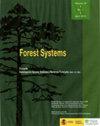智利中部硬叶林中的落叶层隐藏着外来入侵清除者分散后的种子
IF 0.7
4区 农林科学
Q3 FORESTRY
引用次数: 0
摘要
研究目的:种子去除可能是再生的决定性过滤器。落叶、树木覆盖和种子密度等因素会影响种子的去除。本研究旨在评估硬叶林中四种木本物种(Lithraea caustica、Maytenus boaria、Quillaja saponaria和Retanilla ephedra)在扩散后种子去除的三个方面。研究区域:位于智利Río de Los Cipreses国家保护区的Quillaja saponaria和Lithraea caustica的安第斯地中海硬叶林。材料和方法:建立了七个试验区,在试验中提供了不同落叶、树木覆盖和种子密度的种子。采用广义线性混合模型(GLMM)进行统计分析。安装了相机捕捉器来识别种子清除器。主要结果:与其他物种的种子相比,皂荚木种子被去除得更多(0.84,观察平均值)。虽然M.boaria和R.ephedra对其种子的去除率没有显著差异(分别为0.77和0.67),但两者的去除率都高于L.caustica(0.59)。在有落叶的情况下,M.boaria、Q.saponaria和R.ephedra的种子去除率较低。没有任何因素影响黄曲霉种子的去除。种子去除剂被鉴定为入侵外来物种,如Rattus sp.和Oryctolagus cuniculus,以及本地物种,如Lycalopex culpaeus。研究重点:这片森林中的三种木本物种遭受外来入侵动物的严重种子清除,这对这些森林的恢复力产生了重大影响。落叶覆盖是隐藏种子、提高存活率和促进发芽的关键。关键词:外来入侵动物;地中海森林;硬叶林;种子去除因子。本文章由计算机程序翻译,如有差异,请以英文原文为准。
Leaf litter hides post-dispersed seeds from invasive alien removers in a sclerophyll forest in central Chile
Aim of the study: Seed removal may be a determining filter for regeneration. Factors such as leaf litter, tree cover and seed density affect seed removal. This aims to assess three aspects involving on post dispersal seed removal of four woody species (Lithraea caustica, Maytenus boaria, Quillaja saponaria and Retanilla ephedra) of a sclerophyll forest.Study area: Andean Mediterranean sclerophyll forest of Quillaja saponaria and Lithraea caustica located in the Río de Los Cipreses National Reserve, Chile.Materials and methods: Seven experimental plots were set up, in which seeds were offered in an experiment with variations in leaf litter, tree cover and seed density. Generalized Linear Mixed Models (GLMM) were used for the statistical analysis. Camera traps were installed to identify the seed removers.Main results: Q. saponaria seeds were more removed than the seeds of the other species (0.84, observed mean). Whereas that M. boaria and R. ephedra did not show significant differences on the removal of their seeds (0.77 and 0.67 respectively), both were more removed than L. caustica (0.59). The removal of M. boaria, Q. saponaria and R. ephedra seeds was lower in the presence of leaf litter. No factor influenced the removal of L. caustica seeds. Seed removers were identified as invasive alien species such as Rattus sp. and Oryctolagus cuniculus and native species such as Lycalopex culpaeus.Research highlights: Three woody species of this forest suffer severe seed removal by invasive alien fauna with major implications for the resilience of these forests. The coverage of leaf litter is key to hide away the seeds, increasing survival and could promote germination.Keywords: invasive alien fauna; Mediterranean forest; sclerophyll forest; seed removal factors.
求助全文
通过发布文献求助,成功后即可免费获取论文全文。
去求助
来源期刊

Forest Systems
FORESTRY-
CiteScore
1.40
自引率
14.30%
发文量
30
审稿时长
6-12 weeks
期刊介绍:
Forest Systems is an international peer-reviewed journal. The main aim of Forest Systems is to integrate multidisciplinary research with forest management in complex systems with different social and ecological background
 求助内容:
求助内容: 应助结果提醒方式:
应助结果提醒方式:


